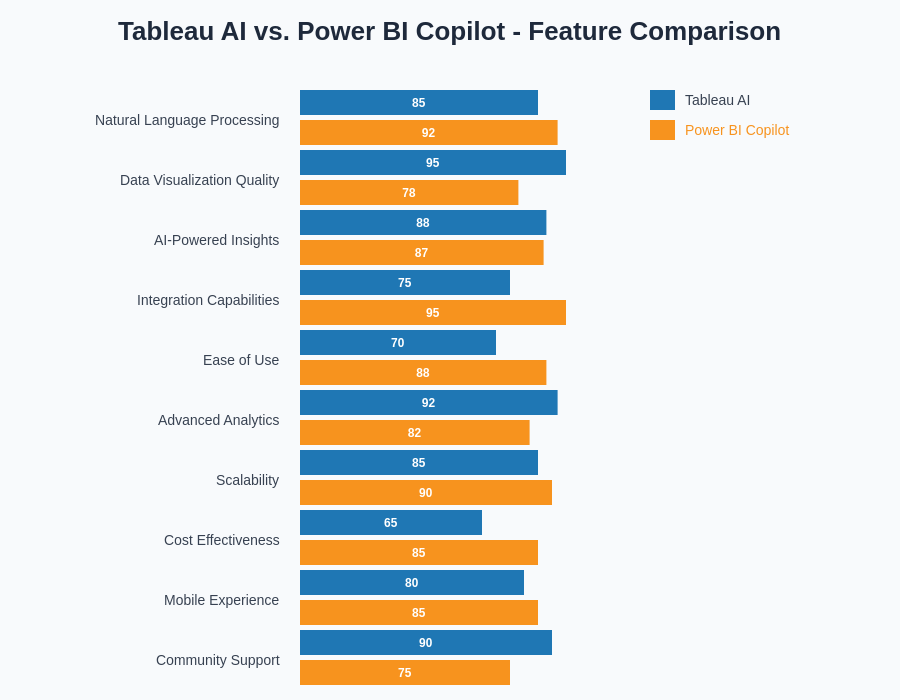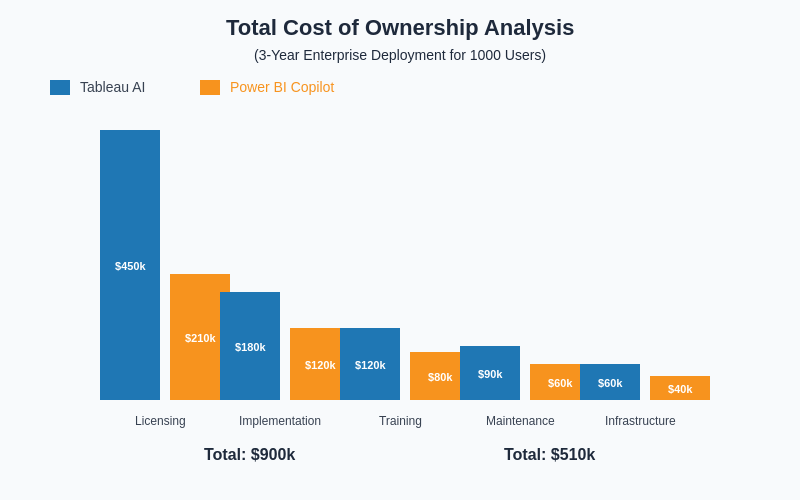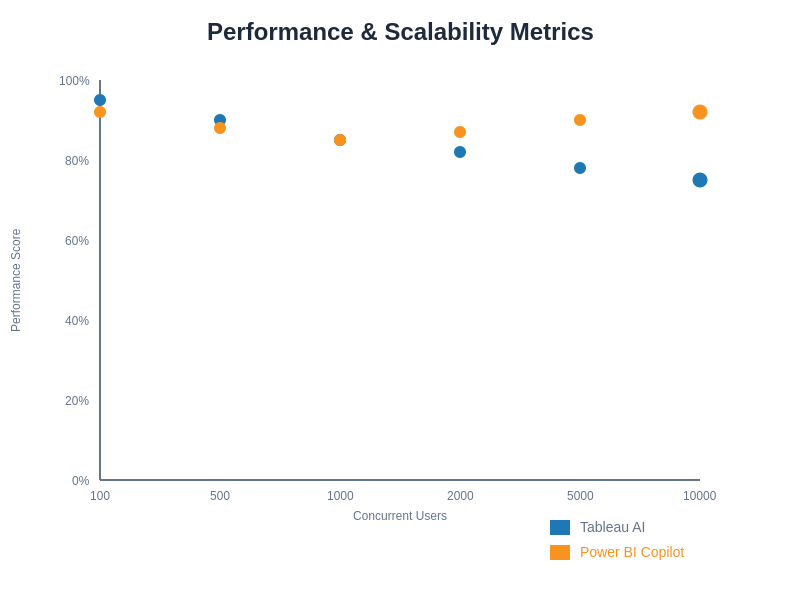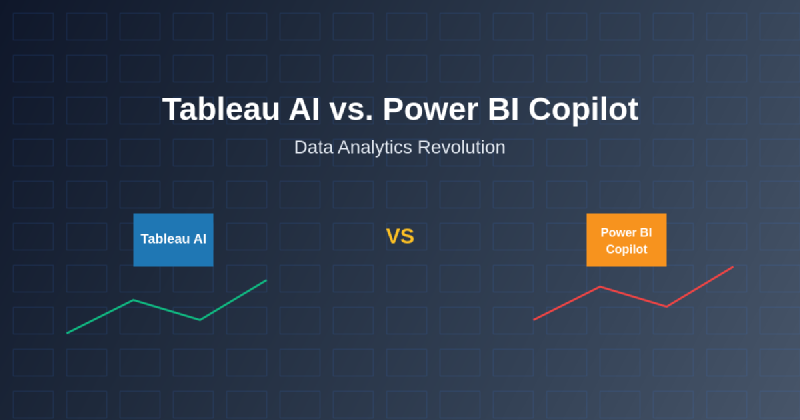The data analytics landscape has entered a transformative era with the introduction of artificial intelligence-powered business intelligence platforms that fundamentally reshape how organizations extract insights from their data. Leading this revolution are two powerhouse platforms: Tableau AI and Microsoft Power BI Copilot, each bringing unique approaches to AI-enhanced analytics that promise to democratize data science capabilities across enterprises of all sizes.
Explore the latest AI analytics trends to understand how these revolutionary platforms are reshaping business intelligence and data-driven decision making across industries. The emergence of AI-powered analytics represents more than technological advancement; it signals a fundamental shift toward intelligent, automated insights that empower users at every organizational level to make data-driven decisions with unprecedented speed and accuracy.
The Evolution of AI-Enhanced Business Intelligence
The traditional approach to business intelligence required extensive technical expertise, complex query languages, and significant time investments to extract meaningful insights from organizational data. Both Tableau AI and Power BI Copilot have disrupted this paradigm by introducing conversational interfaces, automated insight generation, and intelligent data preparation capabilities that transform raw data into actionable business intelligence through natural language interactions and automated analytical processes.
These platforms represent the convergence of advanced machine learning algorithms, natural language processing, and sophisticated visualization engines that work together to eliminate traditional barriers between business users and their data. The result is an analytics environment where complex statistical analyses, predictive modeling, and advanced visualizations become accessible to users regardless of their technical background or statistical expertise.
Tableau AI: Pioneering Intelligent Data Storytelling
Tableau AI represents Salesforce’s ambitious vision for the future of data analytics, integrating advanced artificial intelligence capabilities directly into the renowned Tableau platform that has long been celebrated for its powerful visualization capabilities and intuitive user interface. The AI enhancement brings natural language querying, automated insight discovery, and intelligent data preparation features that significantly reduce the time and expertise required to generate meaningful business insights.
The platform’s AI-powered capabilities extend beyond simple query generation to encompass sophisticated analytical functions including anomaly detection, trend analysis, and predictive forecasting that automatically surface within the user interface as contextually relevant suggestions. This proactive approach to insight generation means that users receive intelligent recommendations about potential areas of investigation, unusual patterns in their data, and predictive scenarios that might require immediate attention or strategic consideration.
Experience advanced AI analytics with Claude for enhanced data analysis, pattern recognition, and strategic insight generation that complements your business intelligence initiatives. The integration of multiple AI tools creates a comprehensive analytics ecosystem that supports everything from data preparation through strategic decision-making processes.
Power BI Copilot: Microsoft’s AI Integration Masterpiece
Microsoft Power BI Copilot represents the company’s strategic integration of its advanced AI capabilities, built on the same foundational technologies that power ChatGPT and other cutting-edge language models, directly into the Power BI ecosystem. This deep integration with Microsoft’s broader AI infrastructure provides users with sophisticated natural language processing capabilities, automated report generation, and intelligent data modeling features that streamline the entire analytics workflow from data ingestion through insight delivery.
The Copilot functionality transforms the Power BI experience by enabling users to interact with their data through conversational interfaces that understand complex business questions and automatically generate appropriate visualizations, calculations, and analytical outputs. This conversational approach to business intelligence removes traditional technical barriers and empowers business users to explore their data intuitively while leveraging advanced analytical capabilities that would traditionally require specialized expertise.
Natural Language Processing Capabilities Comparison
The natural language processing capabilities of both platforms represent significant technological achievements, yet they approach conversational analytics from distinctly different perspectives that reflect their underlying architectural philosophies and target user bases. Tableau AI focuses on generating insights through guided discovery processes that help users explore their data systematically while providing contextual recommendations and automated analysis suggestions throughout the exploration journey.
Power BI Copilot, leveraging Microsoft’s extensive investment in large language models and conversational AI, offers more sophisticated natural language understanding that can interpret complex business questions, understand contextual nuances, and generate comprehensive analytical responses that include multiple visualization options, statistical interpretations, and business recommendations. This advanced language processing capability enables more natural, intuitive interactions that closely mirror how business professionals think about and discuss their data challenges.
Data Preparation and Modeling Advantages
Data preparation represents one of the most time-consuming aspects of traditional analytics workflows, often consuming up to eighty percent of analysts’ time before any meaningful analysis can begin. Both platforms address this challenge through AI-powered automation, but their approaches reflect different philosophies about user control and automation balance.
Tableau AI emphasizes intelligent data profiling and automated data quality assessment that helps users understand their data characteristics, identify potential quality issues, and receive recommendations for data transformation and cleaning processes. The platform maintains a balance between automation and user control, providing intelligent suggestions while preserving the flexibility that experienced Tableau users value for complex analytical projects.
Power BI Copilot takes a more aggressive automation approach, leveraging machine learning algorithms to automatically detect data types, suggest relationships between tables, and propose optimal data models based on the intended analytical use cases. This automation extends to advanced features like automatic generation of measures, calculated columns, and even entire data models based on natural language descriptions of business requirements.

The comprehensive feature comparison reveals distinct strengths and positioning strategies for each platform, with Tableau AI excelling in advanced visualization capabilities and exploratory data analysis, while Power BI Copilot demonstrates superior integration with Microsoft ecosystem tools and more sophisticated natural language processing capabilities.
Visualization and Dashboard Creation Excellence
The visualization capabilities of both platforms showcase their respective strengths in different aspects of data presentation and user interaction design. Tableau AI builds upon the platform’s legendary visualization engine by adding intelligent chart recommendations, automated formatting suggestions, and AI-powered design optimization that helps users create more effective and visually appealing dashboards with minimal manual design effort.
The AI enhancement in Tableau extends to sophisticated features like automatic color scheme selection based on data characteristics, intelligent layout optimization for different screen sizes and viewing contexts, and dynamic visualization type recommendations that adapt based on the underlying data structure and analytical objectives. These capabilities ensure that users can create professional-quality visualizations even without extensive design expertise or deep knowledge of visualization best practices.
Power BI Copilot approaches visualization through a more integrated, conversational methodology that allows users to describe their visualization needs in natural language and receive automatically generated charts, dashboards, and reports that match their specifications. The platform can interpret complex requirements like “show me quarterly revenue trends with forecasting overlays and regional breakdowns” and automatically generate comprehensive dashboards that include multiple related visualizations, appropriate formatting, and contextual insights.
Integration Capabilities and Ecosystem Advantages
The integration capabilities of both platforms reflect their parent companies’ broader strategic visions and existing technology ecosystems, creating distinct advantages for organizations already invested in particular technology stacks. Tableau AI benefits from Salesforce’s extensive customer relationship management and business application ecosystem, providing seamless connectivity with Salesforce CRM data, marketing automation platforms, and other Salesforce cloud services that many enterprises already utilize extensively.
This integration extends beyond simple data connectivity to include sophisticated features like automated insight sharing through Salesforce Chatter, integration with Salesforce Einstein AI capabilities for enhanced predictive analytics, and seamless embedding of Tableau visualizations within Salesforce applications and workflows. Organizations heavily invested in the Salesforce ecosystem find these integrations particularly valuable for creating unified business intelligence experiences that span customer relationship management, sales analytics, and operational reporting.
Power BI Copilot leverages Microsoft’s comprehensive enterprise software ecosystem, providing native integration with Office 365, Azure cloud services, Teams collaboration platform, and the broader Microsoft productivity suite that represents the backbone of many enterprise computing environments. This integration enables sophisticated workflows like automated report distribution through Teams, seamless embedding of Power BI content in SharePoint sites and Office applications, and integration with Azure machine learning services for advanced analytical capabilities.
Enhance your analytics research with Perplexity for comprehensive market analysis, competitive intelligence gathering, and strategic insight development that complements your business intelligence initiatives. The combination of specialized analytics platforms with general-purpose AI research tools creates powerful synergies for informed decision-making.
Performance and Scalability Considerations
The performance characteristics and scalability limitations of both platforms become critical considerations for organizations dealing with large data volumes, complex analytical workloads, and demanding user concurrency requirements. Tableau AI leverages the platform’s mature data engine architecture, which has been optimized over many years to handle complex analytical queries efficiently while maintaining responsive user experiences even with large datasets and sophisticated calculations.
The platform’s approach to performance optimization includes intelligent query optimization, automatic data aggregation strategies, and sophisticated caching mechanisms that ensure consistent performance across different data sources and analytical complexity levels. Tableau’s hybrid architecture allows organizations to balance cloud convenience with on-premises performance requirements, providing flexibility for enterprises with diverse infrastructure and data governance needs.
Power BI Copilot benefits from Microsoft’s extensive cloud infrastructure investment and the mature Azure platform that provides virtually unlimited scalability for data processing and analytical workloads. The platform’s cloud-native architecture enables automatic scaling based on demand, sophisticated data processing capabilities through Azure Synapse Analytics integration, and global content distribution networks that ensure consistent performance regardless of user geographic location.
Security and Governance Framework Comparison
Data security and governance represent paramount concerns for enterprise analytics platforms, particularly as AI capabilities introduce new complexities around data access, automated insight generation, and intelligent content recommendation systems. Both platforms address these challenges through comprehensive security frameworks, but their approaches reflect different philosophical perspectives about balancing accessibility with control.
Tableau AI implements robust security through granular permission systems, row-level security capabilities, and comprehensive audit logging that tracks all user interactions with data and AI-generated insights. The platform provides administrators with detailed control over AI feature availability, ensuring that automated insight generation and natural language querying capabilities can be configured appropriately for different user roles and data sensitivity levels.
Power BI Copilot leverages Microsoft’s enterprise-grade security infrastructure, including Azure Active Directory integration, advanced threat protection, and comprehensive compliance certifications that meet the most stringent regulatory requirements. The platform’s security model extends to AI-powered features through sophisticated mechanisms that ensure conversational interactions with data maintain appropriate access controls and audit trails.
Cost Structure and Value Proposition Analysis
The economic considerations surrounding these platforms encompass not only direct licensing costs but also implementation complexity, training requirements, and total cost of ownership factors that significantly impact long-term value realization for organizations. Tableau AI pricing reflects the platform’s premium positioning in the enterprise analytics market, with costs that reflect sophisticated visualization capabilities, advanced AI features, and comprehensive enterprise support offerings.
The investment in Tableau AI typically justifies itself through improved analyst productivity, reduced time-to-insight, and enhanced decision-making capabilities that drive measurable business outcomes. Organizations find particular value in the platform’s ability to democratize advanced analytics capabilities while maintaining the sophisticated analytical depth required for complex business intelligence initiatives.
Power BI Copilot offers compelling value propositions through Microsoft’s broader enterprise licensing strategies, often providing significant cost advantages for organizations already invested in Microsoft 365 and Azure ecosystems. The platform’s integration with existing Microsoft investments can result in lower total cost of ownership when considered as part of a comprehensive productivity and collaboration platform rather than a standalone analytics solution.

The total cost of ownership analysis reveals significant differences in enterprise deployment expenses, with considerations extending beyond licensing fees to include implementation complexity, training requirements, and ongoing maintenance costs that significantly impact long-term value realization.

The comprehensive performance analysis reveals distinct optimization strategies and scalability characteristics that make each platform suitable for different organizational requirements and usage patterns, with clear implications for enterprise deployment planning and infrastructure investment decisions. The performance comparison demonstrates how each platform handles increasing user loads and data complexity, with Tableau AI maintaining superior performance for smaller deployments while Power BI Copilot shows enhanced scalability for enterprise-level implementations with thousands of concurrent users.
Industry-Specific Use Cases and Applications
Different industries present unique analytical challenges that highlight the relative strengths and weaknesses of each platform in practical business contexts. Financial services organizations often gravitate toward Tableau AI for its sophisticated statistical analysis capabilities, advanced risk modeling features, and flexible visualization options that support complex regulatory reporting requirements and quantitative analysis workflows.
The platform’s strength in exploratory data analysis makes it particularly valuable for financial institutions that need to investigate market trends, analyze trading patterns, and develop sophisticated risk models that require deep analytical capabilities and flexible visualization options. Tableau AI’s ability to handle complex statistical calculations and provide intuitive interfaces for quantitative analysts creates significant value in these demanding analytical environments.
Manufacturing and supply chain organizations frequently find Power BI Copilot’s integration capabilities and operational dashboard focus particularly valuable for monitoring production metrics, tracking supply chain performance, and coordinating across multiple operational systems. The platform’s strength in real-time data integration and automated alerting systems supports the fast-paced, operationally-focused requirements typical of manufacturing environments.
Future Development Trajectories and Innovation Roadmaps
The future evolution of both platforms reflects their parent companies’ broader strategic visions for artificial intelligence, cloud computing, and enterprise software development. Tableau AI development continues to focus on enhancing the platform’s analytical sophistication while maintaining its reputation for visualization excellence and user experience quality that has defined the brand throughout its evolution.
Anticipated developments include more sophisticated machine learning integration, enhanced predictive analytics capabilities, and expanded natural language processing features that will further reduce barriers between business users and advanced analytical capabilities. The platform’s roadmap emphasizes maintaining the balance between automation and user control that appeals to experienced analysts while expanding accessibility for broader user communities.
Power BI Copilot evolution reflects Microsoft’s aggressive investment in artificial intelligence research and development, with future enhancements likely to include more sophisticated conversational capabilities, enhanced integration with Microsoft’s expanding AI services portfolio, and deeper automation of analytical workflows through advanced machine learning algorithms.
Implementation Strategies and Best Practices
Successful implementation of either platform requires careful consideration of organizational readiness, user training requirements, and change management strategies that ensure maximum value realization from AI-enhanced analytics capabilities. Organizations implementing Tableau AI typically benefit from phased rollout approaches that begin with power users and analytical experts before expanding to broader business user communities.
The platform’s sophisticated capabilities require investment in user training and ongoing support structures that help organizations realize the full potential of AI-enhanced analytical capabilities while maintaining data governance standards and analytical quality. Successful Tableau AI implementations often include dedicated centers of excellence that provide ongoing support, best practice development, and advanced training for users at different skill levels.
Power BI Copilot implementations benefit from Microsoft’s comprehensive change management resources and the platform’s integration with familiar Microsoft productivity tools that reduce user adoption barriers. Organizations often find success through implementation strategies that leverage existing Microsoft ecosystem investments while gradually expanding AI-powered analytical capabilities as user comfort and expertise develop.
Strategic Decision Framework and Platform Selection
Choosing between Tableau AI and Power BI Copilot requires comprehensive evaluation of organizational requirements, existing technology investments, user community characteristics, and strategic objectives that extend beyond immediate analytical needs. Organizations with sophisticated analytical requirements, diverse data visualization needs, and user communities that include experienced data analysts often find Tableau AI’s advanced capabilities and flexibility particularly valuable.
The platform’s strength in exploratory data analysis, sophisticated statistical capabilities, and premium visualization options make it ideal for organizations that view analytics as a competitive advantage and are willing to invest in comprehensive training and support structures to maximize platform value. Tableau AI particularly excels in environments where analytical creativity and sophisticated visualization design are important success factors.
Power BI Copilot represents an excellent choice for organizations heavily invested in Microsoft ecosystems, seeking comprehensive integration with existing productivity tools, and prioritizing ease of use and rapid deployment over advanced analytical sophistication. The platform’s conversational interface and automated capabilities make it particularly suitable for organizations seeking to democratize analytics across broad user communities without extensive training investments.
The decision ultimately depends on balancing analytical sophistication requirements, integration priorities, user community characteristics, and total cost of ownership considerations that align with organizational strategic objectives and technology investment philosophies. Both platforms represent significant technological achievements that can drive substantial business value when properly implemented and supported within appropriate organizational contexts.
Conclusion: The Future of AI-Enhanced Analytics
The competition between Tableau AI and Power BI Copilot represents more than a simple platform comparison; it embodies the broader transformation of business intelligence from a specialized technical discipline into a democratized capability that empowers users throughout organizations to leverage data for improved decision-making. Both platforms demonstrate the tremendous potential of artificial intelligence to eliminate traditional barriers between users and their data while maintaining the analytical sophistication required for complex business intelligence initiatives.
The choice between these platforms should be guided by careful consideration of organizational requirements, existing technology investments, user community characteristics, and long-term strategic objectives rather than simple feature comparisons or cost considerations. Success with either platform requires commitment to comprehensive implementation strategies, ongoing user support, and organizational change management that ensures maximum value realization from AI-enhanced analytical capabilities.
The future of business intelligence lies not in the replacement of human analytical expertise but in the intelligent augmentation of human capabilities through sophisticated AI collaboration that enables faster insights, better decisions, and more strategic use of organizational data assets. Both Tableau AI and Power BI Copilot contribute significantly to this transformation, offering different pathways toward the same ultimate objective of democratized, AI-enhanced business intelligence that drives improved organizational performance and competitive advantage.
Disclaimer
This article is for informational purposes only and does not constitute professional advice. The views expressed are based on current understanding of AI-powered analytics platforms and their capabilities in business intelligence applications. Readers should conduct their own research and consider their specific requirements when selecting analytics platforms. Platform capabilities and features may vary based on licensing levels, organizational requirements, and implementation approaches. The effectiveness of AI-enhanced analytics may vary depending on data quality, user expertise, and organizational support structures.
